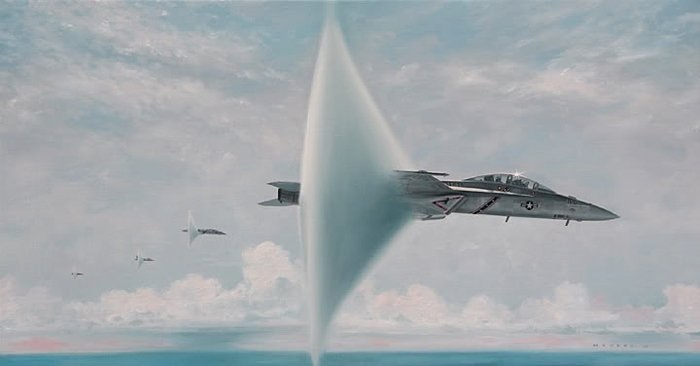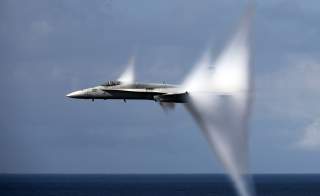The Unknown Story of 4 Simultaneous F/A-18F Super Hornet Sonic Booms That No One Saw
“In my 13 years of flying jet fighters for the Navy, this is easily the coolest thing I’ve seen, but no one in the flight had a camera,” LCDR Andy “Skirt” Mickley, F/A-18F WSO with VFA-22 Fighting Redcocks.
The beautiful artwork in this post was painted by Wade Meyers (be sure to visit his site to see his beautiful paintings) and shows a flight of four F/A-18F Super Hornets from Strike Fighter Squadron 22 (VFA-22), better known as the “Fighting Redcocks,” pulling perfect sonic cones as they transit the Gulf of Mexico above Mach 1 while on a flight from Key West destined for New Orleans. VFA-22 was assigned as part of Carrier Air Wing 14 on the USS Ronald Reagan.

The painting was inspired by a detailed description written by LCDR Andy “Skirt” Mickley, seen here as the WSO in the closest jet.
Here his narrative of the event:
“I’m an US Navy F/A-18F WSO and took part of a flight a couple years ago that I think is worthy of aviation art publishing. Unfortunately, no one had a camera. To set the scene quickly without too much info, we were a flight of 4 F/A-18Fs out of Key West destined for New Orleans. Traveling across the Gulf of Mexico is supersonic and we were all at 1.1 Mach. All four of our jets had well formed sonic cones. Absolutely beautiful!
“In my 13 years of flying jet fighters for the Navy, this is easily the coolest thing I’ve seen, but no one in the flight had a camera.
I am a WSO, previously assigned as the Maintenance Officer in VFA-22, the Fighting Redcocks, assigned to CVW-14 on the USS Ronald Reagan. We flew F/A-18F lot 29 aircraft.
We were a four ship leaving NAS Key West for NAS New Orleans and were transiting supersonic across the Gulf of Mexico.
The sky was brilliant blue, with a few low layer puffy clouds. We were in a wall formation, about a mile between each jet at about 30 000 feet. The sonic cone on each aircraft was perfectly symmetrical, sharp , and did not flicker.
Considering the jet is about 60 feet, long, I would say the cone was 100 feet from top to bottom and side to side. The forward edge was at the mid point of the wing and continued to the aft part of the tail.
The puffy clouds were about 10,000 feet which was about 10 degrees below our horizon and the water was about 15-20 degrees below our horizon. I was on the northern most portion of the formation, with the 3 other jets to the south of me, as we were headed northwest. The time of the day was roughly noon, with the sun mostly straight up, but slightly to the south.”
This first appeared in Aviation Geek Club here.

